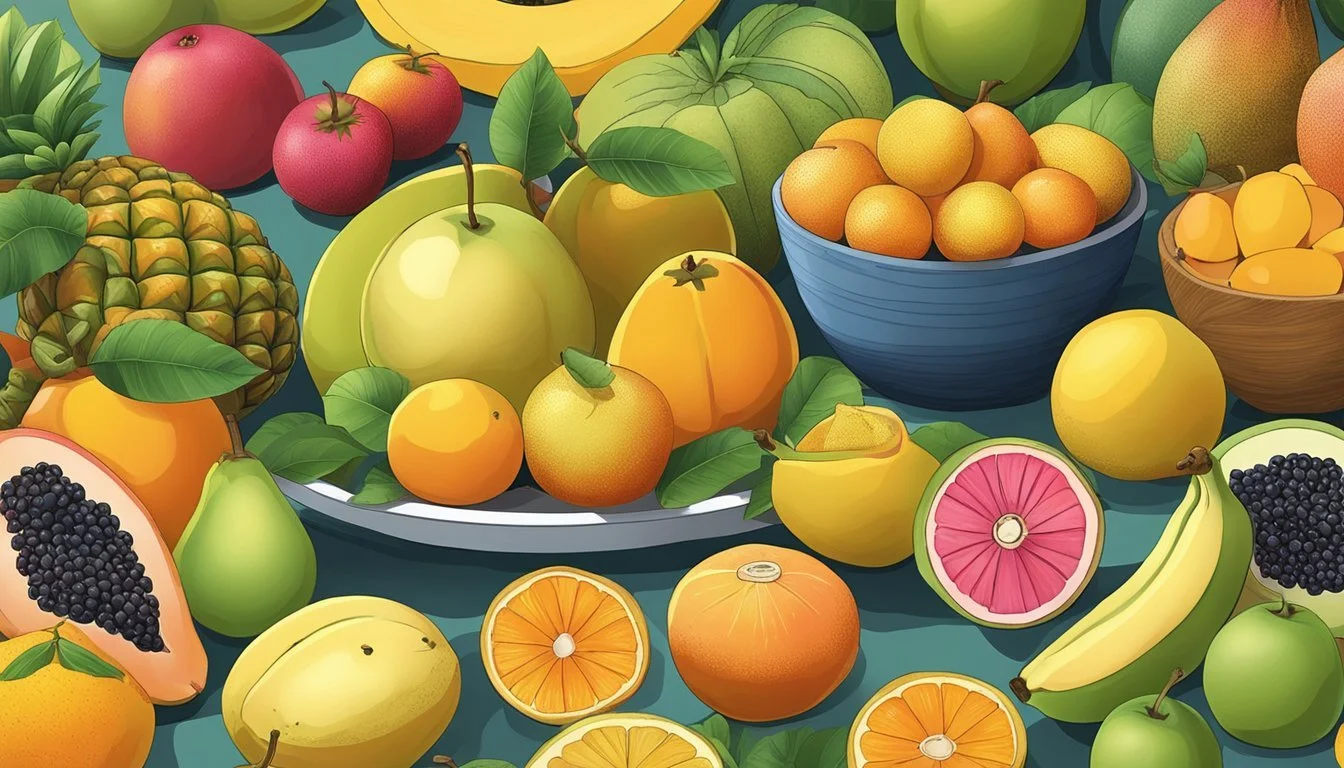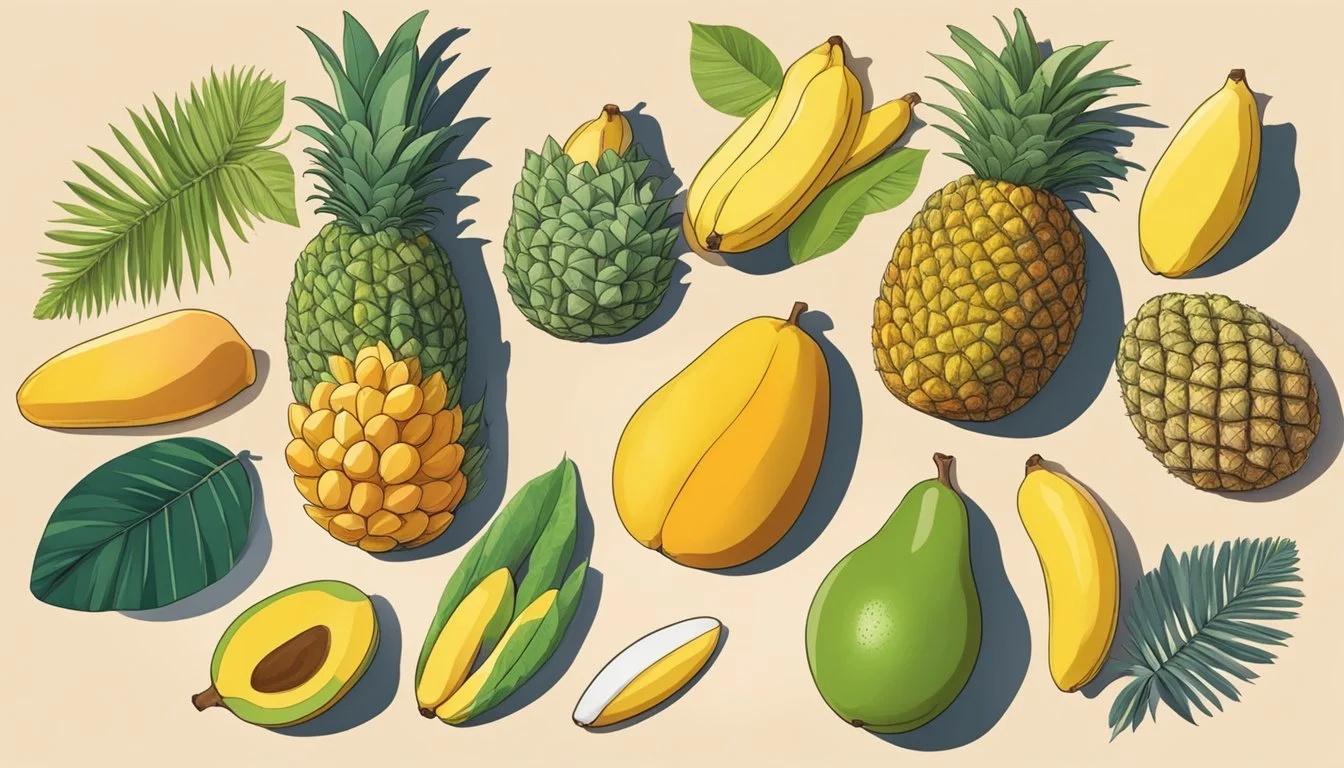Papayas Substitutes
Best Alternatives for Your Recipes
When it comes to finding a substitute for papaya in recipes, there are several options that can match its unique flavor and nutritional benefits. Zucchini, with its sweet-bitter taste, can serve well in most recipes that call for papaya. Whether you're whipping up a flavorful Tinola soup or looking to add some tropical flair to a salad, understanding these alternatives can be essential for those times when papaya is not available.
Other great substitutes include mango and cantaloupe. Mango is a juicy, sweet tropical fruit rich in vitamins A and C, offering a vibrant taste that can complement many dishes as a papaya replacement. For a more neutral flavor, cantaloupe provides a balance of sweet and tart notes, making it suitable for various culinary applications.
In addition to their delightful flavors, many of these substitutes also bring substantial health benefits. For instance, mangoes and cantaloupes are not only tasty but also packed with essential vitamins and minerals, contributing positively to a well-rounded diet. With such versatile options at your disposal, replacing papaya in your favorite recipes becomes a simple yet nutritious task.
Understanding Papayas
Papayas are tropical fruits known for their sweet taste, vibrant orange flesh, and numerous health benefits. Understanding their nutritional profile, culinary uses, and unique attributes can enhance appreciation and utilization in various dishes.
Nutritional Profile
Papayas are rich sources of vitamins and minerals. They are particularly high in Vitamin C, providing more than 200% of the recommended daily intake in one medium-sized fruit. They also contain significant amounts of Vitamin A, Vitamin E, and folate.
Additionally, papayas offer potassium, magnesium, and fiber. This combination supports heart health, digestion, and immune function. With low carbohydrates, minimal fat, and modest protein content, papayas are considered a nutrient-dense, low-calorie fruit ideal for a balanced diet.
Culinary Uses
Papayas' sweet flavor and soft texture make them versatile in the kitchen. They are commonly used in salads, smoothies, and salsas. Their natural sweetness complements both savory and sweet dishes.
In drinks, papayas are often blended into tropical smoothies, adding a rich, creamy texture. They also appear in desserts, such as fruit salads and sorbets. Additionally, green papayas, which are less sweet, are popular in Southeast Asian dishes such as green papaya salad.
Unique Attributes
One of the unique attributes of papayas is their enzymatic properties. They contain an enzyme called papain, which aids in protein digestion and is often used as a meat tenderizer. This enzyme is also utilized in various digestive supplements.
Additionally, the seeds of papayas, while often discarded, have a peppery taste and are sometimes dried and ground as a spice. The fruit's distinctive tropical flavor, combined with its health benefits and culinary versatility, sets papayas apart from other fruits.
Understanding these aspects of papayas will allow individuals to make the most of this tropical delight in their culinary creations and dietary practices.
Choosing Papaya Substitutes
When selecting a substitute for papaya, it's crucial to consider the intended use in the recipe, such as salads, sweet dishes, or beverages. The best substitutes should mimic the flavor, texture, and nutritional benefits of papaya.
Criteria for Substitution
The primary criteria for choosing a papaya substitute include texture, sweetness, and nutritional content, especially fiber and vitamin C. For green papayas, crunchy substitutes like cucumber and carrot work well. For ripe papayas, fruits with a sweet, juicy texture such as mango, peach, and cantaloupe are ideal. Nutritionally, aim for substitutes rich in vitamin C and fiber like kiwi or apple.
Substitutes in Salads
In salads, the texture and mild flavor of green papayas can be mimicked by cucumber, carrot, or kohlrabi. These vegetables provide a satisfying crunch and neutral taste, allowing other ingredients to shine. For a sweeter, juicy twist, mango or honeydew melon can be used to replace ripe papaya, adding both color and tropical sweetness to the dish.
Substitutes in Sweet Dishes
For sweet dishes, mango, peach, or apple are excellent substitutes for ripe papaya. These fruits share a similar sweetness and juicy texture that works well in desserts like fruit salads, pastries, and smoothies. Cranberries or kiwi can also be utilized for added tartness and nutritional benefits, particularly vitamin C, enhancing the overall flavor profile of the dish.
Substitutes in Beverages
In beverages, achieving the right balance of sweetness and texture is important. Pineapple juice, mango, and honey are great substitutes for papaya in smoothies, juices, and cocktails. These options not only provide a similar sweetness but also ensure a refreshing taste. For a unique flavor, kiwi can be added for its tangy and vitamin-rich qualities, making the drink both tasty and nutritious.
By considering these substitutes, you can maintain the desired flavor and nutritional value of your recipes, even without papaya. Adjustments may be needed based on the specific characteristics of each fruit or vegetable used.
Specific Papaya Alternatives
For those who can't get their hands on papaya or are looking for alternatives, there are several substitutes that match its unique flavor and texture, suitable for various culinary uses.
Fruit Alternatives
Mango and Pineapple are two excellent fruit substitutes. Mango provides a similar creamy texture and sweetness, making it great for desserts and smoothies. Pineapple offers a juicy, tangy success, perfect for salads and drinks.
Peaches and Pears serve as suitable options as well. They bring a mild sweetness and are ideal for recipes that require a softer texture. Cantaloupe and Honeydew Melon can also substitute the sweet and juicy nature of ripe papaya.
Vegetable Alternatives
Chayote and Zucchini are excellent when green papaya is required. Chayote, a squash-like vegetable, mimics the mild flavor and slight crunch, ideal for soups and stir-fries. Zucchini, with its tender texture, works well in similar dishes.
Daikon Radish and Jicama are other good choices. Daikon radish has a subtle, peppery flavor that suits savory applications. Jicama is crunchy and has a slightly sweet taste, suitable for salads and fresh dishes.
Tropical Fruit Alternatives
Passion Fruit and Pawpaw are notable choices among tropical fruits. Passion fruit is a bit more tangy and adds a unique zest to recipes. Pawpaw, often confused with papaya, boasts a comparable tropical flavor when ripe.
Mangoes also fit as a tropical alternative, offering a blend of sweetness and creaminess. Cantaloupe brings in a refreshing taste and hydrating properties, making it versatile for both savory and sweet preparations.
Cooked Papaya Substitutes
Butternut Squash and Carrot are leading substitutes when cooked papaya is called for. Butternut squash provides a similar texture and slightly sweet flavor when cooked, fitting well in soups and stews.
Carrots add a sweet undertone and firm texture that holds up in cooked dishes. Chayote, once again, proves to be a reliable substitute due to its adaptability in savory cooking, preserving the dish's intended texture and flavor.
Integrating Substitutes into Recipes
Papaya provides a unique flavor and texture that can be challenging to replace. When incorporating substitutes, it’s important to account for texture differences, nutritional value, flavor balance, and specific cooking techniques. Each substitute offers distinct advantages and adjusting recipes accordingly ensures culinary success.
Adapting to Texture Differences
Substitutes like zucchini, butternut squash, and chayote may offer similar textures. It's essential to prepare these correctly. For example, zucchini should be deseeded and chopped finely to mimic the bulkiness of papaya.
Green papaya salad may require thin slicing of substitutes like daikon or jicama to maintain its crispiness. Making the right choice helps maintain the intended mouthfeel of dishes.
Table: Substitute Textures
Substitute Texture Zucchini Soft Butternut Squash Firm Chayote Crisp
Maintaining Nutritional Value
When papaya’s nutritional benefits are irreplaceable, considering substitutes with similar vitamins and minerals is crucial. Pineapple and cantaloupe are rich in Vitamin C and beta-carotene.
Health Benefits Comparison:
Papaya: Vitamin C, fiber, potassium
Pineapple: Bromelain, Vitamin C
Cantaloupe: Vitamins A and C, fiber
Ensuring that substitutes like bottle gourd or pear offer enough antioxidants and fiber helps keep dishes nutritious and balanced.
Balancing Flavors
Flavor balance is crucial for a satisfactory culinary experience. Pineapple and mango have a sweet-tart profile, closely mirroring papaya’s taste. Conversely, carrot and zucchini offer a more neutral taste, suitable for those who prefer less sweetness.
Considerations:
Sweetness: Mango, pineapple
Neutral Taste: Zucchini, carrot
In tinola, ginger and fish sauce can amplify flavor and complement sweet substitutes, maintaining the dish’s integrity.
Cooking Techniques and Considerations
Different substitutes may require specific cooking adaptations. Green papayas used in savory dishes like chicken tinola can be replaced with bottle gourd or daikon simmered until tender.
Cooking Tips:
Simmering: For firm substitutes like squash
Raw Preparation: For crisp substitutes in salads
Blending: For smooth consistency in drinks and purees
Adapting cooking techniques ensures that substitutes meld well into dishes, preserving the original recipe's intent.
Conclusion
When substituting for papaya in recipes, there are a variety of fruits and vegetables that can be used.
Cantaloupe is an excellent choice as it shares a similar sweet and tart flavor. It also matches well in salads, smoothies, and other dishes.
Mango offers a rich sweetness and works well in both sweet and savory dishes. Its texture and flavor make it a versatile substitute.
Pineapple brings a vibrant, tropical flavor and is ideal for adding a burst of sweetness to any dish. It can replace papaya in fruit salads and desserts.
Peach is another sweet option that can be used in place of papaya. Its juicy texture and mild flavor complement various recipes.
Consider butternut squash for savory dishes. Its rich, slightly sweet taste pairs well in soups and stews.
Other substitutes include pear, passion fruit, honeydew melon, and even carrot for a different flavor profile. Each substitute offers unique benefits, contributing to healthy eating and culinary exploration.
Using these substitutes enables you to maintain nutritional value while experimenting with different flavors and textures in your cooking.






